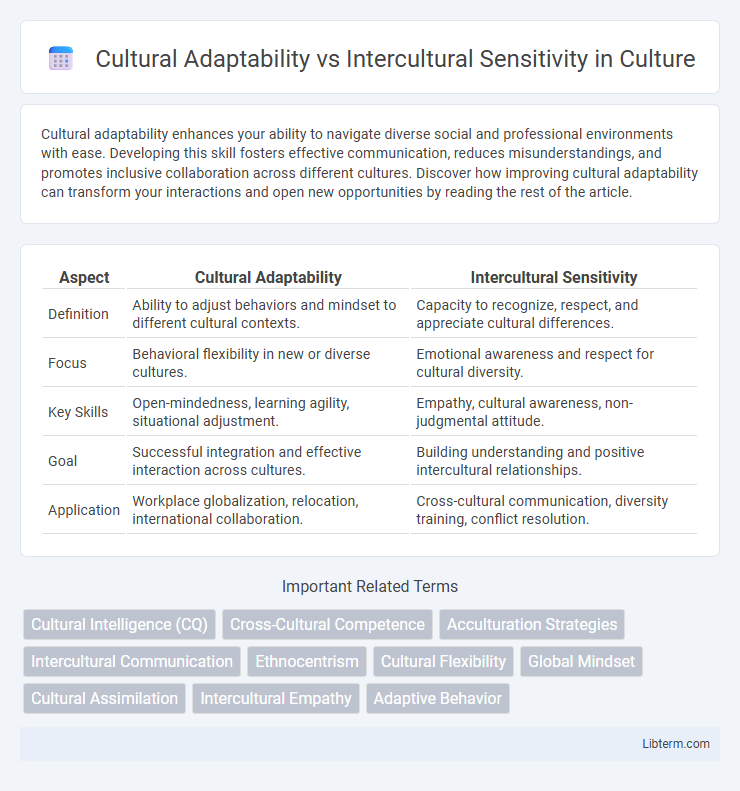Cultural adaptability enhances your ability to navigate diverse social and professional environments with ease. Developing this skill fosters effective communication, reduces misunderstandings, and promotes inclusive collaboration across different cultures. Discover how improving cultural adaptability can transform your interactions and open new opportunities by reading the rest of the article.
Table of Comparison
| Aspect | Cultural Adaptability | Intercultural Sensitivity |
|---|---|---|
| Definition | Ability to adjust behaviors and mindset to different cultural contexts. | Capacity to recognize, respect, and appreciate cultural differences. |
| Focus | Behavioral flexibility in new or diverse cultures. | Emotional awareness and respect for cultural diversity. |
| Key Skills | Open-mindedness, learning agility, situational adjustment. | Empathy, cultural awareness, non-judgmental attitude. |
| Goal | Successful integration and effective interaction across cultures. | Building understanding and positive intercultural relationships. |
| Application | Workplace globalization, relocation, international collaboration. | Cross-cultural communication, diversity training, conflict resolution. |
Understanding Cultural Adaptability
Cultural adaptability refers to an individual's ability to adjust behaviors, communication styles, and thinking patterns to effectively interact with people from diverse cultural backgrounds. This skill involves cognitive flexibility, open-mindedness, and emotional resilience, enabling seamless navigation through unfamiliar cultural contexts. Enhancing cultural adaptability supports improved collaboration, conflict resolution, and overall success in global environments.
Defining Intercultural Sensitivity
Intercultural sensitivity refers to an individual's ability to recognize, respect, and appropriately respond to cultural differences, fostering effective communication across diverse cultural contexts. It involves emotional intelligence and awareness of cultural norms, values, and traditions, enabling empathetic interactions and reducing cultural misunderstandings. Developing intercultural sensitivity enhances collaboration in multicultural environments by promoting openness, patience, and the ability to navigate cultural complexities with respect.
Key Differences Between Cultural Adaptability and Intercultural Sensitivity
Cultural adaptability involves modifying behaviors and strategies to effectively interact within diverse cultural settings, emphasizing flexibility and adjustment. Intercultural sensitivity centers on recognizing, respecting, and appreciating cultural differences, highlighting empathy and awareness. The key difference lies in cultural adaptability focusing on practical behavioral changes, while intercultural sensitivity prioritizes emotional and cognitive understanding of cultural diversity.
Importance of Cultural Adaptability in a Globalized World
Cultural adaptability enhances effective communication and collaboration across diverse cultural contexts, essential in today's globalized economy where cross-border interactions are routine. It enables individuals and organizations to respond flexibly to varying social norms, business practices, and communication styles, fostering inclusive environments and competitive advantages. Developing cultural adaptability directly improves global teamwork, innovation, and market penetration by aligning strategies with local cultural nuances.
The Role of Intercultural Sensitivity in Cross-Cultural Communication
Intercultural sensitivity enhances cross-cultural communication by fostering awareness, respect, and empathy towards diverse cultural perspectives, enabling individuals to navigate cultural differences more effectively. It involves recognizing cultural nuances and emotional responses, which improves interpersonal interactions and reduces misunderstandings. By developing intercultural sensitivity, communicators build trust and collaboration in multicultural environments, facilitating smoother exchanges and more productive outcomes.
Developing Cultural Adaptability Skills
Developing cultural adaptability skills involves enhancing one's ability to adjust behaviors and communication styles in diverse cultural settings, fostering effective interaction across global environments. Mastering cultural adaptability requires ongoing self-awareness, empathy, and active learning about different cultural norms and values to respond appropriately to unfamiliar social dynamics. Building these skills significantly improves cross-cultural collaboration, reduces misunderstandings, and supports successful integration in multinational teams and international contexts.
Enhancing Intercultural Sensitivity: Practical Steps
Enhancing intercultural sensitivity involves active listening, open-mindedness, and empathy towards diverse cultural perspectives. Engaging in cross-cultural experiences and seeking feedback about cultural assumptions sharpens awareness and reduces ethnocentric biases. Practicing reflective observation and continuous learning fosters deeper understanding and respectful communication across cultures.
Challenges in Cultivating Cultural Adaptability and Intercultural Sensitivity
Cultural adaptability challenges often arise from deeply ingrained biases and limited exposure to diverse cultures, making flexible behavior in multicultural environments difficult to develop. Intercultural sensitivity faces obstacles such as emotional resistance and misinterpretation of cultural cues, which hinder the ability to empathize and engage effectively. Both require ongoing self-awareness, immersive experiences, and targeted training programs to overcome these barriers and foster genuine cross-cultural competence.
Measuring Success: Indicators of Cultural Adaptability vs Intercultural Sensitivity
Measuring success in cultural adaptability involves assessing flexibility in behavior, communication styles, and problem-solving across diverse cultural contexts, with indicators such as openness to new experiences and effective adjustment to cultural norms. Intercultural sensitivity is evaluated by the degree of empathy, respect for cultural differences, and the ability to understand and interpret cultural cues accurately. Key performance metrics include cross-cultural conflict resolution skills, emotional intelligence in diverse settings, and demonstrated respect for varying cultural perspectives.
Future Trends in Cross-Cultural Competence
Cultural adaptability increasingly drives success in global interactions by enabling individuals to adjust behaviors based on evolving cultural contexts, while intercultural sensitivity fosters deeper empathy and reduces misunderstandings in diverse environments. Future trends emphasize integrating artificial intelligence with cultural intelligence frameworks to enhance real-time communication and personalized cultural learning. Organizations investing in continuous intercultural training and digital adaptability tools gain competitive advantages in multinational markets.
Cultural Adaptability Infographic

 libterm.com
libterm.com